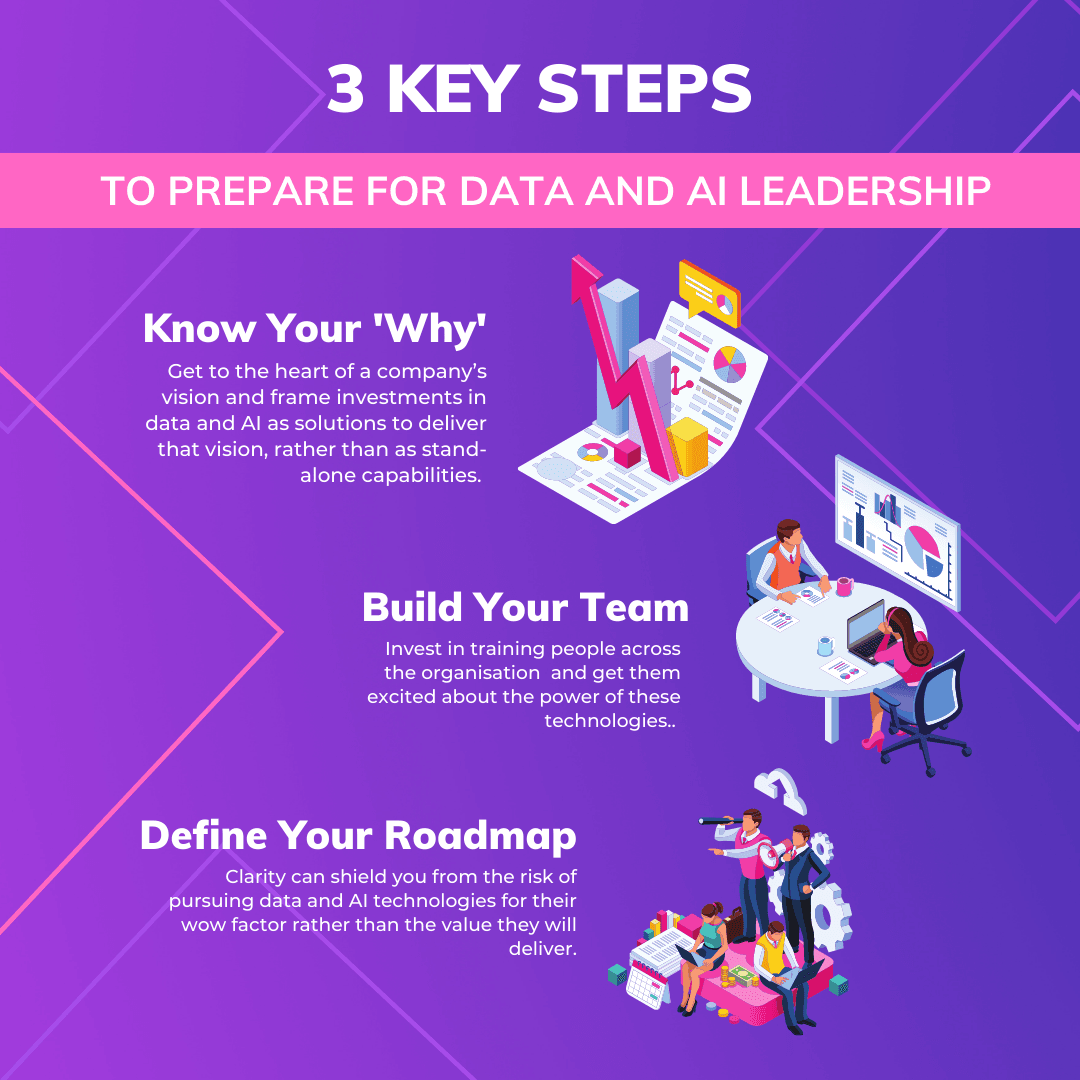Three Key Steps to Prepare for Data and AI Leadership

Image by Gordon Johnson from Pixabay
To harness the potential of new technology, today’s data-driven business leaders must also be politicians and communicators. With Big Data and Artificial Intelligence (AI) transforming business, it is becoming almost certain that every executive will sooner or later need to leverage these technologies to advance their organisation – and their career.
However, doing so carries a heavy intimidation factor for most leaders, which is often exacerbated by job descriptions for leadership roles related to data, analytics or AI featuring laundry lists of skills. Many of these descriptions fundamentally misunderstand what’s required to drive successful business outcomes using data and AI.
While analytical thinking is certainly important, many traditional leadership skills are equally essential when undertaking AI/Big Data for the first time. Some of the most impactful leaders are those who think commercially while applying expertise in data and AI.
It’s also critical to have comfort with ambiguity, the capacity to drive consensus among disparate players, and the ability to understand the levers of value and prioritise accordingly.
Moreover, today’s data-driven business leaders need to be politicians and communicators to harness the potential of data and AI for driving revenue, efficiency gains and innovation, exert influence and explain the value they create. Of course, success also requires knowledge of existing and emerging data and AI technologies – though not necessarily sophisticated technical expertise all around.
You do need sufficient technical knowledge to grasp the likely value, costs and risks associated with implementation, track relevant trends, and inspire data science and engineering teams. However, it is neither necessary nor possible to know it all, so don’t expect to.
While there is a lot to do to prepare yourself and your organisation to leverage these technologies, we outline three key steps to apply in order to succeed as Big Data and AI leaders.

Infographic by Leaderonomics
Read More: Decimation -The New Normal
Know Your 'Why’
Before starting, it’s important to gauge the CEO and executive board’s vision for data and AI. Their commitment is key, but why do they want to build a data capability? Because they read it in a newspaper? Wrong answer. Because consultants told them to? Wrong again. Because their competitors are doing it? Still not right.
Being able to answer the big why question is crucial because it gets to the heart of a company’s vision and frames investments in quality data and AI as solutions to deliver that vision, rather than as stand-alone capabilities.
At Vodafone, for example, Dr Walsh, as the group’s first global Chief Data & AI Officer, sought to crisply articulate the vision, starting with a simple question: Why is it that people cannot live for two minutes without their phone, yet easily switch providers – quitting the very same company that made that phone come to life? The ability to arrive at that clear why allowed her team and their partners to narrow their focus amongst all the possible opportunities with data to those that would allow them to make the company as indispensable to its customers’ lives as the devices it connected for them.
It’s also important to gauge the quality of your organisation’s data. Ask questions such as: Do we have the data necessary to answer the questions that are pertinent to our vision? Is our data consumable and organised? If such questions are not addressed early, you could end up doing data clean-up work for the first three years of a mandate, without being able to deliver much or any value in that time.
If your organisation doesn't have the necessary data, then gathering it will be a critical step. The approach you choose will depend on the resources available to you. You can collect the data if you have the tools, IT solutions and human capital to drive the process. If your priority is saving time and resources, purchasing datasets tailored to your needs is also an option that can provide you with new insights.
You simply can't create value without a single source of accurate and high-quality information.
Build Your Team
When organisations try to turn themselves into a data and AI-ready enterprise, they often focus on hiring the brightest technical minds. Of course, technical talent is very valuable, but data effectiveness can be limited by the motivation and capacity of stakeholders and partners to engage. It is also important – and can at times be more effective, not to mention cost-efficient – to invest in training people across the organisation.
For example, you could identify and train people in sales, marketing and operations on how to identify opportunities and ask questions that help solve business problems through data and AI and get them excited about the power of these technologies. This builds internal support and can be more successful than hiring legions of top technical talent who, in the absence of engaged partners, will struggle to create business value.
In every organisation, there is a point at which it is critical to increase the data literacy of the enterprise. Companies are starting to realise this and invest heavily in employee upskilling. Furthermore, the data and AI teams that are best at driving value contain diverse profiles extending beyond analytics and engineering to anything from quantitative PhDs to philosophy graduates, lawyers, or self-taught experts without university degrees. A quality they should all have in common, however, is resilience. Change management can be arduous work, and the ability to bounce back from setbacks is what carries a team forward.
Read More: Leveraging Technology in Leadership
Define Your Roadmap
Once you’re satisfied with the “why” and “who” of your data and AI endeavour, it’s time to define your “how” – and time is always limited. There are still too many problems within the larger umbrella of an organisation’s mission to solve them all effectively.
Data is a two-sided coin: The great thing is, you can do so much with it; the bad thing is, you can do so much with it.
To deliver business outcomes requires discipline and focus. Having a clear vision and an overarching “why” from the top is critical, but there also needs to be a systematic way of breaking down that vision into concrete goals that a team of analysts, data scientists and engineers can help to achieve.
For example, if the overall goal is to increase customer satisfaction, you still need to define the most effective way of moving that metric. Should you focus on increasing the quality of the user experience? On improved customer service? If so, would it be more effective to develop chatbots, better product recommendations, or better targeted promotions?
Source: Image by mohamed Hassan from Pixabay
There are so many problems to solve in organisations that it can be tempting to jump straight into solution mode. Although you must be quick on your feet and begin to deliver value early on, it’s important to continuously improve your understanding of problems and to socialise them with relevant stakeholders and partners. This ensures that the right solution is brought to bear on the right situation.
Clarity regarding the most critical business problems can shield you from the risk of pursuing data and AI technologies for their wow factor rather than the value they will deliver.
With clearly identified, defined and well-scoped problems that support your “why,” what order should you pursue them in? The obvious answer is by ranking opportunities according to the likely value they will deliver and the feasibility of success, picking those that are most likely to deliver the greatest return.
Assessing the technical feasibility, based also on the availability and quality of necessary data, is only part of the equation. Feasibility will critically depend on working with stakeholders and partners who are clear about what they seek, and who are engaged and open to trying new things. It also helps if they are honest and values-oriented because data can reveal uncomfortable truths.
Another key dimension is also how long it’s likely to take to deliver that expected value. People lose patience, so it’s important to prioritise data and AI applications that build momentum and deliver value quickly. In many organisations, it’s often the simple applications that build the most momentum and help convert the sceptics.
McMillan, Morgan Stanley’s Chief Data & Analytics Officer, first concentrated on giving stakeholders better access to basic information – such as sales figures – instead of chasing the most tempting opportunities using AI and machine learning (ML). By doubling down on training junior people in data visualisation and data warehouse access, McMillan engendered tremendous trust, buy in and support to then pursue ambitious projects using more advanced AI and ML technologies.
Closing Thoughts
At the end of the day, you don’t get credit for making it harder than it needs to be, you get credit for adding value.
Whilst we are on the topic of technological advancements and their values, click on the below to check out this amazing AI powered learning app, Necole. Necole is a state of the art learning platform that curates personalised learning just for you!
Do you have a desire to accelerate your growth? Find out more about Necole, click here or email info@leaderonomics.com.

This article is republished courtesy of INSEAD Knowledge. Copyright INSEAD 2021.
Leadership






